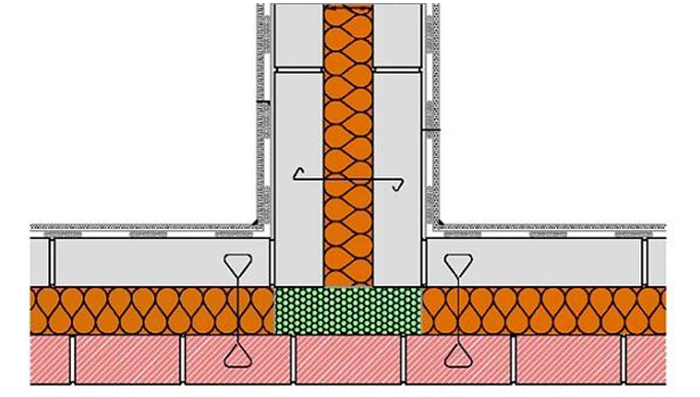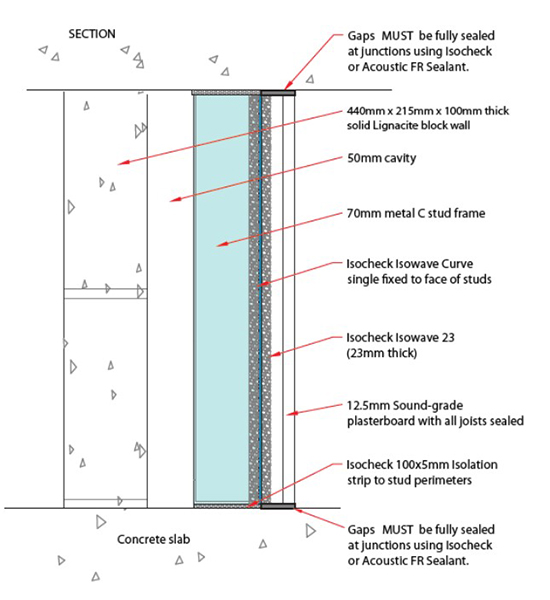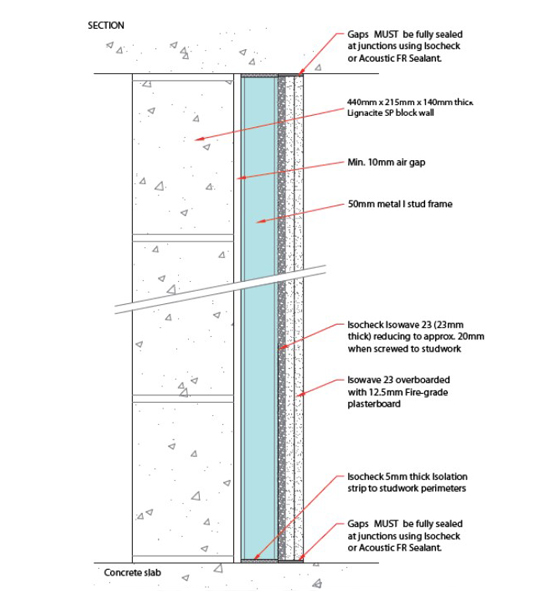The predominant method of building homes remains traditional brick and block construction. Today, approximately 80% of all new homes built in England use brick and block. Meeting sound insulation standards is a key requirement for most building types. Lignacite provides an overview of the masonry solutions that are available.
The current acoustic standards have been in force since 2004 and do appear to be effective in eradicating noise complaints and achieving a better quality of life for building home occupants.
Specific sound performance targets, particularly those limiting sound transfer between adjoining dwellings, are incorporated into Approved Document E1, under Part E of the Building Regulations. The performance requirements cover a range of sound frequencies from 100 Hz (low frequency) to 3150 Hz (high frequency).
For dwellings, there are two ways for demonstrating compliance:
■ Robust Details (RDs) − There are numerous RD specifications available for masonry walls and these are predominantly of cavity construction, with cavity widths of 75 to 100mm.
This is the most popular method of compliance for house builders and avoids any potential pitfalls when using non RD specifications. Evidence obtained through the RD evaluation process has also identified constructions that are capable of achieving a significant uplift in performance, with specifications that can perform 3, 5, and 8 dB better than the minimum performance standard.
■ Pre-Completion Testing (PCT) − where sound tests are undertaken at the end of the build and a test report is produced that details the performance levels achieved.
Approved Document E provides a number of compliant solid and cavity wall constructions to select from, but in reality any masonry construction can be adopted as long as the designer has evidence to prove the construction has a realistic chance of achieving the performance standards when tested.
Choice of masonry wall specification
Party walls can be constructed using dense or lightweight blocks. This generally encompasses concrete blocks such as Lignacite Ash GP/Lignacrete in the 1350-2000kg/m3 density range.
Compliance can be achieved with a cavity width of 75-100mm. Most party walls will incorporate full-fill cavity insulation. This is done primarily for thermal compliance, in avoiding heat by-pass upwards via the cavity.
Achieving enhanced levels of sound insulation
There is often a requirement for walls in buildings other than dwellings, to achieve a higher level of sound insulation.
Often, the performance of such walls be conveyed as a weighted sound reduction index, Rw.
This term describes the airborne sound insulating power of a building element. It is a laboratory-measured value as defined in ISO 717: Part 1. It can apply to walls, ceiling/ floors, ceiling/roofs, doors, or windows. The higher the number, the greater the sound insulating power of the building element. It is measured over the frequency range 100 to 3150Hz. Depending on its composition and density, and any applied finishes, standard blockwork construction can provide an Rw of up to around 57dB.
An example at the higher performance end can be achieved by a 215mm dense block wall with a plaster finish. Where performance in excess of this is required, consideration should be given to using concrete blockwork with an acoustic panel to one side.
The panel typically comprises a 50 or 70mm ‘C’ stud frame, set back about 15mm from the face of the blockwork, with acoustic quilt or a proprietary board between or over the studs and finished with high density plasterboard. The advantage of this construction is that it allows blockwork to be used fair face one side. The blockwork and acoustic panel act together to provided elevated levels of sound insulation.
The benefits of using Concrete Blockwork in dwellings [BLOG]
Lignacite
View company profile| T | (01842) 810678 |
|---|---|
| 01842 810678 Tech Dept. | |
| F | (01842) 814602 |
| E | info@lignacite.co.uk |
| W | Visit Lignacite's website |
| Head Office, Norfolk House, High St, Brandon, Suffolk, IP27 0AX |



